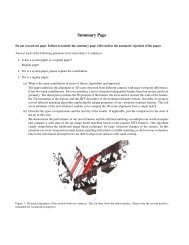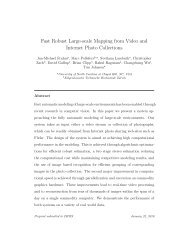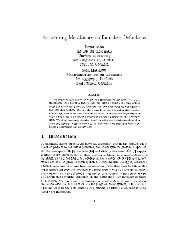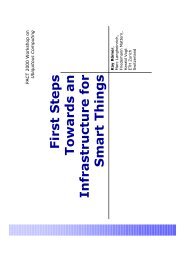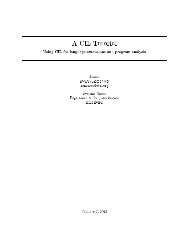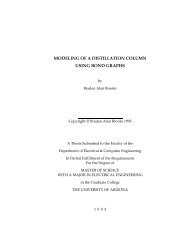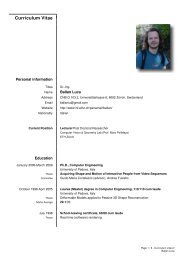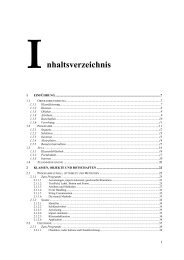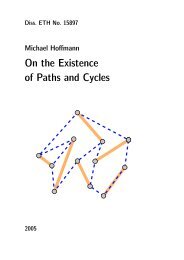Computation of optical modes in axisymmetric open cavity resonators
Computation of optical modes in axisymmetric open cavity resonators
Computation of optical modes in axisymmetric open cavity resonators
Create successful ePaper yourself
Turn your PDF publications into a flip-book with our unique Google optimized e-Paper software.
Future Generation Computer Systems xxx (2004) xxx–xxx<br />
<strong>Computation</strong> <strong>of</strong> <strong>optical</strong> <strong>modes</strong> <strong>in</strong> <strong>axisymmetric</strong> <strong>open</strong><br />
<strong>cavity</strong> <strong>resonators</strong><br />
O. Ch<strong>in</strong>ellato a,∗ , P. Arbenz a , M. Streiff b , A. Witzig b<br />
a Institute <strong>of</strong> <strong>Computation</strong>al Science, Swiss Federal Institute <strong>of</strong> Technology, CH-8092 Zurich, Switzerland<br />
b Integrated Systems Laboratory, Swiss Federal Institute <strong>of</strong> Technology, CH-8092 Zurich, Switzerland<br />
Abstract<br />
The computation <strong>of</strong> <strong>optical</strong> <strong>modes</strong> <strong>in</strong>side <strong>axisymmetric</strong> <strong>cavity</strong> <strong>resonators</strong> with a general spatial permittivity pr<strong>of</strong>ile is a<br />
formidable computational task. In order to avoid spurious <strong>modes</strong> the vector Helmholtz equations are discretised by a mixed f<strong>in</strong>ite<br />
element approach. We formulate the method for first and second order Nédélec edge and Lagrange nodal elements. We discuss<br />
how to accurately compute the element matrices and solve the result<strong>in</strong>g large sparse complex symmetric eigenvalue problems. We<br />
validate our approach by three numerical examples that conta<strong>in</strong> vary<strong>in</strong>g material parameters and absorb<strong>in</strong>g boundary conditions<br />
(ABC).<br />
© 2004 Elsevier B.V. All rights reserved.<br />
Keywords: Optical mode computation; Numerical device simulation; Axisymmetric <strong>cavity</strong>; Body <strong>of</strong> revolution; Semiconductor laser; F<strong>in</strong>ite<br />
element method; Large sparse complex symmetric eigenproblem; Jacobi–Davidson algorithm; Nédélecedge elements<br />
1. Introduction<br />
In this paper we discuss the comprehensive computation<br />
<strong>of</strong> <strong>optical</strong> <strong>modes</strong> <strong>in</strong>side <strong>axisymmetric</strong> <strong>cavity</strong> <strong>resonators</strong>.<br />
If <strong>optical</strong> ga<strong>in</strong>, radiation, and absorption losses<br />
are taken <strong>in</strong>to account, the numerical solution <strong>of</strong> complex<br />
symmetric eigenproblems is required. In this work<br />
the latter result from a f<strong>in</strong>ite element method (FEM)<br />
discretisation <strong>of</strong> the vector Helmholtz eigenproblem<br />
(VHEP) for <strong>open</strong> cavities. Typical <strong>resonators</strong>, the opti-<br />
∗ Correspond<strong>in</strong>g author.<br />
E-mail addresses: ch<strong>in</strong>ellato@<strong>in</strong>f.ethz.ch (O. Ch<strong>in</strong>ellato), arbenz@<strong>in</strong>f.ethz.ch<br />
(P. Arbenz), streiff@iis.ee.ethz.ch (M. Streiff),<br />
witzig@iis.ee.ethz.ch (A. Witzig)<br />
cal <strong>modes</strong> <strong>of</strong> which are <strong>of</strong> <strong>in</strong>terest, are semiconductor<br />
lasers [34,32], lossy waveguides [16], circular-grat<strong>in</strong>g<br />
<strong>resonators</strong> [23], photonic bandgap structures [20].<br />
Until recently, new resonator designs and changes<br />
to the design <strong>of</strong> exist<strong>in</strong>g devices had to be <strong>in</strong>vestigated<br />
purely experimentally, by chang<strong>in</strong>g the <strong>cavity</strong> structure,<br />
fabricat<strong>in</strong>g and characteris<strong>in</strong>g the device. Due to<br />
the sav<strong>in</strong>gs <strong>in</strong> design time and cost, comprehensive<br />
simulators are becom<strong>in</strong>g essential tools to explore the<br />
design parameter space for an optimal solution. The<br />
foundations <strong>of</strong> such a simulator will be discussed <strong>in</strong><br />
this article.<br />
From the po<strong>in</strong>t <strong>of</strong> view <strong>of</strong> comput<strong>in</strong>g <strong>optical</strong> <strong>modes</strong>,<br />
a resonator structure is described <strong>in</strong> terms <strong>of</strong> a spatially<br />
non-uniform complex symmetric permittivity function<br />
0167-739X/$ – see front matter © 2004 Elsevier B.V. All rights reserved.<br />
doi:10.1016/j.future.2004.09.008
2 O. Ch<strong>in</strong>ellato et al. / Future Generation Computer Systems xxx (2004) xxx–xxx<br />
Fig. 1. Left: a possible <strong>axisymmetric</strong> <strong>cavity</strong> resonator consist<strong>in</strong>g <strong>of</strong><br />
different dielectric media described by a permittivity tensor ε(x).<br />
Right: <strong>in</strong> this example, the material arrangement can be described by<br />
the cross-section alone. The <strong>open</strong> resonator is composed <strong>of</strong> several<br />
dielectric media, ○1 ,...,○4 , surround<strong>in</strong>g air ○5 and the PML ○6 .<br />
ε(x), see Fig. 1. As mentioned earlier, we restrict our<br />
attention to <strong>axisymmetric</strong> structures.<br />
In order to simulate radiation leakage from the <strong>cavity</strong><br />
one has to make sure that outside the <strong>cavity</strong> electromagnetic<br />
waves are only outgo<strong>in</strong>g. If it is possible to<br />
ext<strong>in</strong>guish the electro-magnetic waves outside the <strong>cavity</strong><br />
without caus<strong>in</strong>g any back-scatter<strong>in</strong>g the computational<br />
doma<strong>in</strong> can be truncated and made f<strong>in</strong>ite without<br />
chang<strong>in</strong>g the wave <strong>in</strong>side the <strong>cavity</strong>. This can be<br />
accomplished by an absorb<strong>in</strong>g layer.<br />
A method that has been used for <strong>open</strong> region scatter<strong>in</strong>g<br />
problems [13], is to model the absorber as lossy<br />
perfectly matched layer (PML) [5,29]. The characteristics<br />
<strong>of</strong> the PML are first, waves propagat<strong>in</strong>g through<br />
the PML are attenuated and second, the reflection coefficient<br />
is zero. Such a PML is available for cyl<strong>in</strong>drical<br />
coord<strong>in</strong>ates [33] and is used here to compute the <strong>optical</strong><br />
<strong>modes</strong> <strong>of</strong> <strong>open</strong> cavities.<br />
A simulation tool has to be capable <strong>of</strong> handl<strong>in</strong>g very<br />
general spatial permittivity pr<strong>of</strong>iles ε(x) to be <strong>of</strong> practical<br />
use. Various methods to compute <strong>optical</strong> <strong>modes</strong><br />
<strong>of</strong> resonant cavities were proposed <strong>in</strong> the past, yet only<br />
some <strong>of</strong> them [6,22,28,30,32] are suited to treat a general<br />
form <strong>of</strong> a non-uniform dielectric function.<br />
The paper is organized as follows. In Section 2 we<br />
give a weak formulation <strong>of</strong> the problem. The frequency<br />
doma<strong>in</strong> FEM formulation <strong>of</strong> the dielectric <strong>optical</strong> resonator<br />
problem employed <strong>in</strong> this work is related to<br />
[17,27,28,32]. With this approach, <strong>in</strong> pr<strong>in</strong>ciple, <strong>optical</strong><br />
<strong>modes</strong> for arbitrary cavities can be computed. Typically,<br />
us<strong>in</strong>g a 2D body <strong>of</strong> revolution (BOR) expansion<br />
for an <strong>axisymmetric</strong> device, large sparse generalised<br />
complex symmetric eigenvalue problems <strong>of</strong> the<br />
order <strong>of</strong> approximately 500,000 have to be solved. The<br />
present article assesses the value <strong>of</strong> higher order f<strong>in</strong>ite<br />
element functions for this approach. In Section 3 we<br />
discuss a f<strong>in</strong>ite element discretisation <strong>of</strong> the problem<br />
that avoids spurious <strong>modes</strong>. We deal with the accurate<br />
computation <strong>of</strong> the f<strong>in</strong>ite element matrices and the numerical<br />
solution <strong>of</strong> the result<strong>in</strong>g eigenvalue problem. In<br />
Section 4 we present three experiments with the purpose<br />
to demonstrate the superiority <strong>of</strong> the quadratic<br />
over the l<strong>in</strong>ear elements and the flexibility <strong>of</strong> our approach<br />
<strong>in</strong> deal<strong>in</strong>g with different media, <strong>in</strong>clud<strong>in</strong>g absorb<strong>in</strong>g<br />
ones. Both these features constitute the important<br />
build<strong>in</strong>g blocks for the <strong>in</strong>vestigation <strong>of</strong> realistic<br />
<strong>optical</strong> <strong>resonators</strong> as shown <strong>in</strong> Fig. 1. We draw our<br />
conclusions <strong>in</strong> Section 5.<br />
2. Formulation <strong>of</strong> the problem<br />
As mentioned earlier, we want to <strong>in</strong>vestigate the resonance<br />
behaviour <strong>of</strong> <strong>axisymmetric</strong> cavities by approximatively<br />
solv<strong>in</strong>g the correspond<strong>in</strong>g VHEPs. The latter<br />
arise (implicitly) whenever the Maxwell equations are<br />
used to express vector fields, which, by virtue <strong>of</strong> the<br />
aforementioned resonance behaviour, are assumed to<br />
be time-harmonic. In that case the s<strong>in</strong>usoidal ansatz is<br />
chosen to be F(x,t) = Re[F(x)e iωt ], where F is any <strong>of</strong><br />
the considered vector fields. In this paper we only work<br />
with the electric field E.<br />
If we assume that the <strong>cavity</strong>—modelled as a<br />
bounded simply connected doma<strong>in</strong> Ω—is nondriven<br />
(J = 0), charge free (ρ = 0) and possesses a<br />
perfectly electrically conduct<strong>in</strong>g (PEC) boundary Γ =<br />
∂Ω, Maxwell’s frequency doma<strong>in</strong> equations [15] can<br />
be comb<strong>in</strong>ed lead<strong>in</strong>g to the follow<strong>in</strong>g problem.<br />
Problem 1 (VHEP). F<strong>in</strong>d a vector field E ≠ 0 and<br />
λ ∈ C, such that<br />
∇×µ −1 ∇×E = λεE ∀x ∈ Ω, (1)<br />
∇·εE = 0 ∀x ∈ Ω, (2)<br />
n × E = 0 ∀x ∈ Γ (3)<br />
hold, where n denotes the outer surface normal on Γ =<br />
∂Ω and λ = ω 2 /c 2 .
O. Ch<strong>in</strong>ellato et al. / Future Generation Computer Systems xxx (2004) xxx–xxx 3<br />
Recall, that accord<strong>in</strong>g to the constitutive relations,<br />
the complex symmetric tensors ε(x) and µ(x) describe<br />
the materials’ permittivity and permeability, respectively.<br />
The divergence free condition (2) serves as a filter, <strong>in</strong><br />
that it discards all scalar potential field solutions, i.e. the<br />
fields constitut<strong>in</strong>g the <strong>in</strong>f<strong>in</strong>ite-dimensional null space<br />
<strong>of</strong> the curl–curl operator. Conversely, any divergence<br />
free solution E is guaranteed to be associated with a<br />
non-zero eigenvalue λ, see [11].<br />
Solv<strong>in</strong>g these problems exactly is not possible except<br />
for a few particular geometries and media comb<strong>in</strong>ations,<br />
see [19]. It is therefore reasonable to compute<br />
approximate solutions, e.g. by apply<strong>in</strong>g the FEM approach.<br />
To this end, Problem 1 needs to be recast <strong>in</strong>to<br />
its weak form.<br />
Problem 2 (weak VHEP). F<strong>in</strong>d E ∈ H 0 (curl; Ω) \{0}<br />
and λ ∈ C, such that for all V ∈ H 0 (curl; Ω) and ψ ∈<br />
H0 1(Ω)<br />
∫<br />
∫<br />
〈∇ × V, ∇×E〉 µ −1 dΩ = λ 〈V, E〉 ε dΩ, (4)<br />
∫<br />
Ω<br />
Ω<br />
〈∇ψ, E〉 ε dΩ = 0 (5)<br />
hold, where 〈u, v〉 =u T v = ∑ k u kv k is a complex<br />
symmetric bil<strong>in</strong>ear form and 〈u, v〉 A =〈u, Av〉.<br />
For the def<strong>in</strong>ition <strong>of</strong> these function spaces we refer<br />
to [11]. Resonator cavities, such as semiconductor<br />
lasers, are <strong>of</strong>ten <strong>axisymmetric</strong>, <strong>in</strong> which case the<br />
problem above is best described by means <strong>of</strong> cyl<strong>in</strong>der<br />
coord<strong>in</strong>ates<br />
E(x) = U(φ)Ê(r) = U(φ)[Ê r (r), Ê φ (r), Ê z (r)] T<br />
ψ(x) = ˆψ(r),<br />
Ω<br />
and<br />
where U(φ) conta<strong>in</strong>s the cyl<strong>in</strong>drical unit vectors and<br />
Ê(r) represents the correspond<strong>in</strong>g coord<strong>in</strong>ates. The advantages<br />
<strong>of</strong> this transform become evident, if the material<br />
tensors µ and ε have no angular dependency. In<br />
this case a Fourier series expansion <strong>of</strong> the fields and<br />
potentials <strong>in</strong>volved <strong>in</strong> Problem 2<br />
Ê(r) =<br />
∞∑<br />
m=0<br />
Ê (c)<br />
m<br />
and<br />
(r, z) cos(mφ) + Ê(s) (r, z) s<strong>in</strong>(mφ)<br />
m<br />
ˆψ(r) =<br />
∞∑<br />
m=0<br />
ˆψ (c)<br />
m (r, z) cos(mφ) + ˆψ m (s) (r, z) s<strong>in</strong>(mφ)<br />
nicely isolates all azimuthal <strong>in</strong>fluences. We def<strong>in</strong>e<br />
Ê m,p (c) = [Ê(c) m,r , Ê(c) m,z ]T and Ê m,p (s) = [Ê(s) m,r , Ê(s) m,z ]T , replace<br />
the Cartesian curl and gradient operators <strong>in</strong><br />
Problem 2 with their cyl<strong>in</strong>drical counterparts and f<strong>in</strong>ally<br />
apply the above Fourier expansions. The orig<strong>in</strong>al<br />
problem then splits <strong>in</strong>to a sequence <strong>of</strong> two-dimensional<br />
eigenvalue problems, one for each angular wave number<br />
m. Notice, that the pairwise orthogonality <strong>of</strong> the<br />
Fourier basis functions <strong>in</strong>duces a pairwise decoupl<strong>in</strong>g<br />
<strong>of</strong> the aforementioned lower-dimensional eigenvalue<br />
problems. In order to keep formulations compact, let<br />
us <strong>in</strong>troduce the bil<strong>in</strong>ear forms a i (·, ·) and b j (·, ·),<br />
∫<br />
a 1 (v, u) = r〈∇ p × v, ∇ p × u〉 ˆµ<br />
−1 dΩ p ,<br />
Ω φ<br />
p<br />
∫<br />
a 2 (v, u) = r −1 〈v, u〉 ˆµ −1 dΩ p,<br />
p<br />
Ω p<br />
∫<br />
a 3 (v,u) = r −1 〈v, ∇ p (ru)〉 ˆµ −1 dΩ p,<br />
p<br />
Ω p<br />
∫<br />
a 4 (v, u) = r −1 〈∇ p (rv), ∇ p (ru)〉 ˆµ −1 dΩ p,<br />
p<br />
Ω p<br />
∫<br />
b 1 (v, u) = r〈v, u〉ˆεp dΩ p ,<br />
Ω p<br />
∫<br />
b 2 (v, u) = r〈v, u〉ˆεφ dΩ p . (6)<br />
Ω p<br />
Here, ∇ p denotes the Cartesian operator with respect<br />
to the coord<strong>in</strong>ates (r, z). Problem 2 can now be recast<br />
<strong>in</strong>to its cyl<strong>in</strong>drical counterpart. Thereby, we neglect<br />
the divergence free condition, s<strong>in</strong>ce accord<strong>in</strong>g<br />
to the aforementioned filter property it suffices to<br />
consider only non-zero eigenvalues. For the sake <strong>of</strong><br />
brevity the subscript m will be omitted <strong>in</strong> the follow<strong>in</strong>g<br />
problem.<br />
Problem 3 (weak <strong>axisymmetric</strong> VHEP). Let m ∈<br />
N 0 be a given angular wave number and Ω =<br />
[0, 2π] × Ω p an <strong>axisymmetric</strong> <strong>cavity</strong>. F<strong>in</strong>d Ê (c) , Ê (s) ∈<br />
Ĥ 0 (curl; Ω p ) \{0} and λ ∈ C, such that for all<br />
ˆV (c) , ˆV (s) ∈ Ĥ 0 (curl; Ω p )
4 O. Ch<strong>in</strong>ellato et al. / Future Generation Computer Systems xxx (2004) xxx–xxx<br />
a 1 ( ˆV (c)<br />
p , Ê(c) p ) + a 4( ˆV (s)<br />
φ , Ê(s) φ ) + m2 a 2 ( ˆV (c)<br />
p , Ê(c) p )<br />
+ma 3 ( ˆV p (c) , Ê(s) φ ) + ma 3(Ê p (c) , ˆV (s)<br />
φ )<br />
= λb 1 ( ˆV (c)<br />
p , Ê(c) p ) + λb 2( ˆV (s)<br />
a 1 ( ˆV p (s) , Ê(s) p ) + a 4( ˆV (c)<br />
φ<br />
, Ê(c)<br />
φ , Ê(s) φ<br />
φ ) + m2 a 2 ( ˆV (s)<br />
−ma 3 ( ˆV p (s) , Ê(c) φ ) − ma 3(Ê p (s) , ˆV (c)<br />
φ )<br />
), (7)<br />
p , Ê(s) p )<br />
= λb 1 ( ˆV p (s) , Ê(s) p ) + λb 2( ˆV (c)<br />
φ , Ê(c) φ ) (8)<br />
hold.<br />
Notice that the new function space Ĥ 0 (curl; Ω p )is<br />
derived from H 0 (curl; Ω) by apply<strong>in</strong>g the above transformations,<br />
lead<strong>in</strong>g to<br />
Ĥ 0 (curl; Ω p ) =<br />
{<br />
W(r) :W ∈ ˆL 2 (Ω p ) 3 , ∇ p × W p<br />
∈ ˆL 2 (Ω p ), 1 r (mW p +∇ p (rW θ ))<br />
}<br />
∈ ˆL 2 (Ω p ) 2 , W p × n p = W θ = 0 ∀r ∈ Γ p ,<br />
where Γ p = ∂Ω p \{(0, R)}, see [24].<br />
In addition, we assume that the formerly mentioned<br />
tensors are available <strong>in</strong> diagonal form,<br />
i.e. ˆµ = U T µU = diag( ˆµ r , ˆµ φ , ˆµ z ) and ˆε = U T εU =<br />
diag(ˆε r , ˆε φ , ˆε z ). From this we derive the matrices ˆµ p =<br />
diag( ˆµ r , ˆµ z ) and ˆε p = diag(ˆε r , ˆε z ), <strong>in</strong> accordance with<br />
the def<strong>in</strong>itions <strong>of</strong> the planar subcomponents Ê p<br />
(c) and<br />
Ê p (s)<br />
Ẇe conclude this section by po<strong>in</strong>t<strong>in</strong>g out that any<br />
solution <strong>of</strong> subproblem (7) can be transformed <strong>in</strong>to<br />
a solution <strong>of</strong> (8) by a simple sign change <strong>in</strong> the azimuthal<br />
component, i.e. Ê p<br />
(s) = Ê(c) p and Ê(c) φ =−Ê(s) φ .<br />
Therefore it suffices to compute solutions <strong>of</strong> one<br />
subproblem—we opt for (7).<br />
3. F<strong>in</strong>ite element discretisation<br />
In this section we discuss how to obta<strong>in</strong> approximate<br />
solutions <strong>of</strong> subproblem (7) us<strong>in</strong>g the FEM. We<br />
assume, that the cross-section Ω p has been discretised<br />
by means <strong>of</strong> a mixed regular mesh consist<strong>in</strong>g <strong>of</strong> a set<br />
<strong>of</strong> triangles T and paraxial rectangles R.<br />
The next step <strong>in</strong> the FEM process consists <strong>in</strong> def<strong>in</strong><strong>in</strong>g<br />
piecewise polynomial basis functions whose supports<br />
are spatially conf<strong>in</strong>ed and whose span forms a<br />
subset <strong>of</strong> the spaces Ĥ 0 (curl; Ω p ) and Ĥ0 1(Ω p). The<br />
application <strong>of</strong> the weak form (7) to these f<strong>in</strong>ite element<br />
functions will then lead to a f<strong>in</strong>ite-dimensional approximation<br />
<strong>of</strong> the operator (7).<br />
Unfortunately the choice <strong>of</strong> appropriate f<strong>in</strong>ite element<br />
functions is very delicate, ma<strong>in</strong>ly because <strong>of</strong> the<br />
cont<strong>in</strong>uous operator hav<strong>in</strong>g <strong>in</strong>f<strong>in</strong>itely many zero eigenvalues.<br />
The degenerate null space has to be reflected by<br />
the discrete operator as well, <strong>in</strong> order to obta<strong>in</strong> reasonable<br />
approximations, see e.g. [7–9,14,21]. If this is not<br />
done properly, so-called spurious <strong>modes</strong>, i.e. eigenvalues<br />
with no physical mean<strong>in</strong>g, are likely to arise.<br />
A possible choice that avoids this spectral pollution<br />
consists <strong>in</strong> modell<strong>in</strong>g the field components Ê p<br />
(c) and<br />
Ê (s)<br />
φ<br />
, respectively, by Nédélec edge and modified Lagrange<br />
nodal element functions, as described <strong>in</strong> [25].<br />
These so called hybrid element functions are guaranteed<br />
to reproduce a portion <strong>of</strong> the null space correctly<br />
and thus lead to spurious free approximations.<br />
It is well known, that the quality <strong>of</strong> FEM approximations<br />
depends on the mesh width as well as on the<br />
order <strong>of</strong> the element functions. In this article we will use<br />
both, first and second order hybrid element functions<br />
def<strong>in</strong>ed over both, triangles and paraxial rectangles.<br />
To be more precise, we def<strong>in</strong>e T 0 to be the reference<br />
triangle with vertices (0, 0), (1, 0) and (0, 1).<br />
Additionally, we <strong>in</strong>troduce the simplex coord<strong>in</strong>ates<br />
Fig. 2. Vector element functions N T i<br />
obta<strong>in</strong>ed by “cyclic rotation”.<br />
1 , NT i<br />
4 and NT i<br />
7 related to the bottom edge <strong>of</strong> an arbitrary triangle T i. The other vector functions can be
O. Ch<strong>in</strong>ellato et al. / Future Generation Computer Systems xxx (2004) xxx–xxx 5<br />
Fig. 3. DOF placement for triangles. The positions <strong>of</strong> the nodal functions are marked as white numbered dots, whereas vector functions are<br />
represented by means <strong>of</strong> white numbered arrows. Left: first order functions; right: second order functions <strong>in</strong>clud<strong>in</strong>g <strong>in</strong>terior ones.<br />
ζ 1 = 1 − r − z, ζ 2 = r and ζ 3 = z. The element functions<br />
whose support <strong>in</strong>tersect T 0 (see Fig. 2) are then<br />
def<strong>in</strong>ed as [18]<br />
N T 0<br />
i (r, z) = ζ i N T 0<br />
i (r, z) = ζ i ∇ p ζ i+1 − ζ i+1 ∇ p ζ i<br />
N T 0<br />
i+3 (r, z) = 4ζ i+1ζ i N T 0<br />
i+3 (r, z) = ζ i ∇ p ζ i+1 + ζ i+1 ∇ p ζ i<br />
N T 0<br />
i+6 (r, z) = ζ i+2(ζ i ∇ p ζ i+1 − ζ i+1 ∇ p ζ i )<br />
where the <strong>in</strong>dices <strong>of</strong> the ζ functions wrap <strong>in</strong> modulo<br />
arithmetic fashion and i = 1, 2, 3. See Fig. 3 <strong>in</strong> order<br />
to understand how to <strong>in</strong>terpret the degrees <strong>of</strong> freedom<br />
(DOF).<br />
In analogy to T 0 , let R 0 be the reference rectangle<br />
with vertices (0, 0), (1, 0), (1, 1) and (0, 1). Aga<strong>in</strong>,<br />
we <strong>in</strong>troduce new coord<strong>in</strong>ates ζ 1 = 1 − r, ζ 2 = 1 − z,<br />
ζ 3 = r and ζ 4 = z. The element functions whose support<br />
<strong>in</strong>tersect with R 0 (see Fig. 4) are then def<strong>in</strong>ed to<br />
be [18]<br />
N R0<br />
i (r, z) = ζ i ζ i+1 N R0<br />
(r, z) =−ζ i+1 ∇ p ζ i<br />
N R0<br />
i+4 (r, z) = 4 ζ iζ i+1 ζ i+2 N R0<br />
i+4 (r, z) = (1 − 2ζ i)ζ i+1 ∇ p ζ i<br />
N R0<br />
9 (r, z) = 16 ζ 1ζ 2 ζ 3 ζ 4 N R0<br />
i+8 (r, z) = ζ iζ i+1 ζ i+2 ∇ p ζ i+1<br />
where the <strong>in</strong>dices <strong>of</strong> the ζ wrap <strong>in</strong> modulo arithmetic<br />
fashion and i = 1, 2, 3, 4. See Fig. 5 <strong>in</strong> order to understand<br />
how to <strong>in</strong>terpret the DOF.<br />
i<br />
Note that <strong>in</strong> both cases, the left columns represent<br />
the nodal element functions whereas the right<br />
columns denote the vector element functions. Moreover,<br />
if the approximation is <strong>of</strong> first order, only the first<br />
row <strong>of</strong> functions is used <strong>in</strong> each case. For second order<br />
approximations, the rema<strong>in</strong><strong>in</strong>g functions are <strong>in</strong>corporated<br />
<strong>in</strong>to the discrete spaces as well. However, before<br />
these functions can be used, they must be (aff<strong>in</strong>ely)<br />
mapped onto each <strong>of</strong> the triangles T i and rectangles<br />
R j .<br />
The f<strong>in</strong>ite element functions, whose restriction to a<br />
s<strong>in</strong>gle polygon has been described above, constitute the<br />
discrete function space, <strong>in</strong> which the desired approximations<br />
reside. In order to compute these approximations,<br />
it is necessary to construct the discrete operators<br />
described by the weak form (7). To this end we expand<br />
the field components used <strong>in</strong> Problem 3 by means <strong>of</strong><br />
the f<strong>in</strong>ite element functions given above, i.e.<br />
{ }<br />
Ê(c) p<br />
ˆV p<br />
(c) = ∑ k<br />
{ }<br />
Ê(s) φ<br />
ˆV (s) = ∑<br />
φ k<br />
{<br />
xk<br />
˜x k<br />
}<br />
N k (r, z)<br />
and<br />
{<br />
yk<br />
ỹ k<br />
}<br />
r −1 N k (r, z), (9)<br />
Fig. 4. Vector element functions N R j<br />
can be obta<strong>in</strong>ed by “cyclic rotation”.<br />
1 , NR j<br />
5 and N R j<br />
9 related to the bottom edge <strong>of</strong> an arbitrary paraxial rectangle R j . The other vector functions
6 O. Ch<strong>in</strong>ellato et al. / Future Generation Computer Systems xxx (2004) xxx–xxx<br />
Fig. 5. DOF placement for rectangles. The positions <strong>of</strong> the nodal functions are marked as white numbered dots, whereas vector functions are<br />
represented by means <strong>of</strong> white numbered arrows. Left: first order functions; right: second order functions <strong>in</strong>clud<strong>in</strong>g <strong>in</strong>terior ones.<br />
where the element functions are now globally numbered.<br />
Note, that the r −1 factor <strong>in</strong> front <strong>of</strong> N k (r, z)isthe<br />
modification which guarantees spurious free approximations.<br />
Unfortunately, the price for this modification<br />
is a change <strong>in</strong> the set <strong>of</strong> boundary conditions prescribed<br />
by Ĥ 0 (curl; Ω p ).<br />
Insert<strong>in</strong>g the f<strong>in</strong>ite element expansions (9) <strong>in</strong>to the<br />
weak form (7) and consider<strong>in</strong>g that the latter must hold<br />
for all functions ˆV p (c),<br />
ˆV (s)<br />
φ , leads to an eigenvalue problem<br />
[ ][ ]<br />
A1 + m 2 A 2 mA 3 x<br />
Az =<br />
mA T 3<br />
A 4 y<br />
[ ][ ]<br />
B1 0 x<br />
= λ<br />
= λBz, (10)<br />
0 B 2 y<br />
where the sub–blocks A i and B j are associated with<br />
the correspond<strong>in</strong>g bil<strong>in</strong>ear forms a i (·, ·) and b j (·, ·) <strong>in</strong><br />
(6).<br />
An important po<strong>in</strong>t to note is that both, the <strong>in</strong>ner<br />
products and the tensors, are symmetric. S<strong>in</strong>ce the latter<br />
may be complex, the result<strong>in</strong>g general eigenvalue<br />
problem (10) turns out to be complex symmetric, as<br />
well. In addition, both matrices A and B will be sparse,<br />
due to the locally conf<strong>in</strong>ed supports <strong>of</strong> the f<strong>in</strong>ite element<br />
functions.<br />
3.1. Accurate evaluation <strong>of</strong> bil<strong>in</strong>ear forms<br />
Despite the formal simplicity <strong>of</strong> the matrix assembl<strong>in</strong>g<br />
process, care has to be taken when numerically<br />
evaluat<strong>in</strong>g the <strong>in</strong>tegrals given by the bil<strong>in</strong>ear forms (6).<br />
Recall, that even though the element functions N i (r, z)<br />
and N j (r, z) are mere polynomials q(r, z), some <strong>of</strong> the<br />
<strong>in</strong>tegrals possess a weight<strong>in</strong>g term r −1 . Explicit evaluation<br />
<strong>of</strong> these <strong>in</strong>tegrals leads to very large expressions<br />
which suffer from cancellation. The alternative application<br />
<strong>of</strong> standard numerical <strong>in</strong>tegration techniques, such<br />
as Gaussian quadrature, requires many function evaluations<br />
<strong>in</strong> order to obta<strong>in</strong> accurate results, which becomes<br />
even worse, if tensor product rules are used. Moreover,<br />
such straightforward numerical quadrature would lead<br />
to cancellation.<br />
To avoid these problems, we transform <strong>in</strong>tegrals<br />
over triangles <strong>in</strong>to <strong>in</strong>tegrals over triangle boundaries,<br />
i.e. sums <strong>of</strong> one-dimensional <strong>in</strong>tegrals. By apply<strong>in</strong>g<br />
Green’s theorem we get<br />
∫<br />
∫<br />
x −1 q(x, y)dT = x −1 Q(x, y)d∂T<br />
T<br />
∂T<br />
= ∑ ∫ 1<br />
u k (x k + u k t) −1 Q(x k + u k t, y k + v k t)dt,<br />
k<br />
0<br />
where Q(x, y) = ∫ q(x, y)dy. The parameters u k =<br />
x k+1 − x k and v k = y k+1 − y k denote the differences<br />
between the x and y coord<strong>in</strong>ates <strong>of</strong> the counterclockwise<br />
oriented triangle vertices (x k ,y k ) with k = 1, 2, 3.<br />
Integrals over paraxial rectangles are recast <strong>in</strong>to<br />
product form and lead to <strong>in</strong>tegrals <strong>of</strong> the form<br />
∫<br />
∫ 1<br />
x −1 q(x, y)dR = u 0 (x 0 + u 0 t) −1<br />
R<br />
[Q(x 0 + u 0 t, y 0 + v 0 ) − Q(x 0 + u 0 t, y 0 )] dt,<br />
0<br />
where aga<strong>in</strong>, the parameters depend on the underly<strong>in</strong>g<br />
rectangle, i.e. (x 0 ,y 0 ) denotes its lower left corner and<br />
u 0 and v 0 its width and height, respectively.
O. Ch<strong>in</strong>ellato et al. / Future Generation Computer Systems xxx (2004) xxx–xxx 7<br />
Hence, the orig<strong>in</strong>al <strong>in</strong>tegration problem can be reduced<br />
to a set <strong>of</strong> l<strong>in</strong>e <strong>in</strong>tegrals with weight function<br />
(α + βt) −1 , for which the construction <strong>of</strong> appropriate<br />
Gauss quadrature rules is feasible. Notice, that each element<br />
requires its own quadrature rule! Nevertheless,<br />
these quadrature rules can be constructed cheaply [12],<br />
whence the bil<strong>in</strong>ear forms can be evaluated efficiently<br />
and accurately.<br />
4. Numerical experiments<br />
This section is devoted to the validation <strong>of</strong> the<br />
previously described modell<strong>in</strong>g process. To this end<br />
we <strong>in</strong>vestigate cavities whose geometries and material<br />
arrangements admit solv<strong>in</strong>g (1) <strong>in</strong> closed form. The analytical<br />
solutions can then be compared to the approximate<br />
ones, obta<strong>in</strong>ed from solv<strong>in</strong>g the FEM models.<br />
Note that throughout this section we assume that µ = I.<br />
In order to compute a few <strong>of</strong> the eigenvalues <strong>of</strong><br />
the generalised complex symmetric eigenvalue problem<br />
(10) close to a target value τ it is advisable to<br />
transform it <strong>in</strong>to the form<br />
(A − σB) −1 Bz = νz, ν = (λ − σ) −1 , (11)<br />
where σ is a shift equal or close to the target. The latter is<br />
usually found by means <strong>of</strong> a related simplified problem.<br />
(11) is called a shift-and-<strong>in</strong>vert spectral transformation<br />
[4] with shift σ. By means <strong>of</strong> the spectral transformation<br />
the eigenvalues <strong>of</strong> the matrix pencil (A; B) that are<br />
close to the shift become the largest <strong>in</strong> modulus <strong>of</strong> (11).<br />
The eigenvectors rema<strong>in</strong> unchanged.<br />
The Arnoldi algorithm is a well-known method for<br />
calculat<strong>in</strong>g a few <strong>of</strong> the extremal eigenvalues <strong>of</strong> a large<br />
matrix. We use the implicitly restarted Arnoldi algorithm<br />
as it is implemented <strong>in</strong> the Matlab function<br />
eigs. eigs actually is an <strong>in</strong>terface to a compiled<br />
rout<strong>in</strong>e <strong>of</strong> ARPACK [26]. The implicit restarts make<br />
it possible to control the memory requirements without<br />
los<strong>in</strong>g the favourable convergence properties <strong>of</strong> the<br />
Arnoldi algorithm.<br />
The shift-and-<strong>in</strong>vert spectral transformation exposes<br />
the <strong>in</strong>terior eigenvalues close to the shift. But<br />
the transformation entails that a system <strong>of</strong> equations <strong>of</strong><br />
the form<br />
(A − σB)x = By (12)<br />
must be solved <strong>in</strong> every step <strong>of</strong> the Arnoldi iteration.<br />
As our problems are not too large we use a direct solver<br />
to this end. Notice that it is important to permute the<br />
matrix A − σB to reduce fill-<strong>in</strong>, e.g. by m<strong>in</strong>imum degree<br />
reorder<strong>in</strong>g. By suppress<strong>in</strong>g pivot<strong>in</strong>g we can save<br />
the symmetry <strong>of</strong> the problem, however at the expense<br />
<strong>of</strong> stability! When A − σB will become too large to<br />
be factored we will employ a variant <strong>of</strong> the Jacobi–<br />
Davidson algorithm, JDCS, that has been adapted to<br />
the complex symmetric eigenvalue problem [3].<br />
4.1. A hollow cyl<strong>in</strong>der <strong>cavity</strong><br />
The first <strong>cavity</strong> we <strong>in</strong>vestigate is a hollow cyl<strong>in</strong>drical<br />
resonator. We assume the cyl<strong>in</strong>der is empty (ε = I)<br />
with unit radius and height (R = H = 1) and surrounded<br />
by a PEC layer. The exact solutions can be<br />
constructed by separation <strong>of</strong> variables, see [19]. Thus,<br />
the eigenvalues can be expressed <strong>in</strong> the form<br />
⎧<br />
⎨<br />
⎩<br />
λ (TM)<br />
m,n,l<br />
λ (TE)<br />
m,n,l+1<br />
⎫ { }<br />
⎬ b<br />
2<br />
⎭ = m,n<br />
b ′ 2<br />
m,n<br />
R −2 + l 2 π 2 H −2 ,<br />
m, l = 0, 1, 2,..., n= 1, 2, 3,... (13)<br />
Here b m,n denotes the nth root <strong>of</strong> the Bessel function<br />
J m (x) and b m,n ′ denotes the nth root <strong>of</strong> its first derivative<br />
J m ′ (x). Some <strong>of</strong> the roots b m,n and b m,n ′ are listed <strong>in</strong> [2].<br />
This is a real eigenvalue problem. The desired eigenvalues<br />
are the lowest ones. In Figs. 6 and 7 the convergence<br />
<strong>of</strong> a few <strong>of</strong> these eigenvalues is plotted <strong>in</strong> log–<br />
log scale. The plots confirm the theoretically predicted<br />
convergence behaviour. The l<strong>in</strong>ear elements have l<strong>in</strong>ear<br />
convergence rate, the quadratic elements display a<br />
quadratic convergence rate. By consequence, the eigenvalues<br />
converge quadratically <strong>in</strong> case <strong>of</strong> a first order approximation<br />
and quartically <strong>in</strong> case <strong>of</strong> a second order<br />
one.<br />
In Table 1, another po<strong>in</strong>t <strong>of</strong> view <strong>of</strong> the same data is<br />
given. There, DpD (DOF-per-Digit) denotes the factor<br />
by which the number <strong>of</strong> the degrees <strong>of</strong> freedom have to<br />
be multiplied to ga<strong>in</strong> a decimal digit <strong>in</strong> accuracy. The<br />
lower this factor the better. Aga<strong>in</strong>, it is clear that for a<br />
given accuracy many fewer degrees <strong>of</strong> freedom are required<br />
with the quadratic than with the l<strong>in</strong>ear elements.<br />
The factors for the rectangles are better than those for<br />
the triangles. However, the difference at least for the<br />
second order elements, is small.
8 O. Ch<strong>in</strong>ellato et al. / Future Generation Computer Systems xxx (2004) xxx–xxx<br />
Fig. 6. Comparison <strong>of</strong> first and second order functions over triangular elements. The plots show the relative errors <strong>of</strong> a few <strong>of</strong> the smallest<br />
eigenvalues w.r.t. the mesh width, us<strong>in</strong>g first order (th<strong>in</strong>) and second order (thick) elements. The random triangular meshes were generated<br />
us<strong>in</strong>g Matlab’s Pde tool. Left: angular wavenumber m = 0. Relative error <strong>of</strong> λ (TM)<br />
010 (solid), λ (TM)<br />
011 (dashed) and λ (TE)<br />
011 (dotted). Right: angular<br />
wavenumber m = 1. Relative error <strong>of</strong> λ (TE)<br />
111 (solid), λ(TM)<br />
110 (dashed) and λ (TM)<br />
111 (dotted).<br />
4.2. Two concentric dielectric spheres<br />
In this second example we consider a <strong>cavity</strong> consist<strong>in</strong>g<br />
<strong>of</strong> two concentric dielectric spheres with radii<br />
a = 1 and b = 2, respectively. Moreover, the permittivity<br />
<strong>of</strong> the <strong>in</strong>ner sphere is ε a = 10 whereas the outer<br />
sphere is empty (ε b = 1) and enclosed by a PEC layer.<br />
Notice that the use <strong>of</strong> different media can easily be<br />
<strong>in</strong>corporated <strong>in</strong>to our model.<br />
The computation <strong>of</strong> the exact solution can be carried<br />
out follow<strong>in</strong>g the l<strong>in</strong>es <strong>of</strong> [1]. Let k = √ λ, k a = k √ ε a<br />
and k b = k √ ε b . Then, the characteristic equations for<br />
the eigenvalues can be expressed by means <strong>of</strong> the determ<strong>in</strong>ants<br />
∣<br />
0 − J +(k b b)<br />
√<br />
kb b<br />
− J +(k a b)<br />
√<br />
ka b<br />
k a J − (k a a)<br />
√<br />
ka a<br />
and<br />
J + (k a b)<br />
√<br />
kb b<br />
− k bJ − (k b a)<br />
√<br />
kb a<br />
− Y +(k b b)<br />
√<br />
kb b<br />
Y + (k a b)<br />
√<br />
kb b<br />
− k bJ − (k b a)<br />
√<br />
kb a<br />
= 0 (14)<br />
∣<br />
Fig. 7. Comparison <strong>of</strong> first and second order functions over rectangular elements. The plots show the relative errors <strong>of</strong> a few <strong>of</strong> the smallest<br />
eigenvalues w.r.t. the mesh width, us<strong>in</strong>g first order (th<strong>in</strong>) and second order (thick) elements. The meshes consisted <strong>of</strong> equidistant squares and<br />
were generated by the commercially available mesh generator <strong>of</strong> ISE. Left: angular wavenumber m = 0. Relative error <strong>of</strong> λ (TM)<br />
010 (solid), λ (TM)<br />
011<br />
(dashed) and λ (TE)<br />
011<br />
(dotted). Right: angular wavenumber m = 1. Relative error <strong>of</strong> λ(TE)<br />
111 (solid), λ(TM)<br />
110 (dashed) and λ (TM)<br />
111 (dotted).
O. Ch<strong>in</strong>ellato et al. / Future Generation Computer Systems xxx (2004) xxx–xxx 9<br />
Table 1<br />
Comparison <strong>of</strong> the DOF-per-Digit ratio between first and second order element approximations<br />
DpD[△]<br />
DpD[□]<br />
First order<br />
λ (TM)<br />
010 10.4 11.1<br />
λ (TM)<br />
011 10.6 10.8<br />
λ (TE)<br />
011 12.3 12.5<br />
λ (TE)<br />
111 13.3 11.1<br />
λ (TM)<br />
110 13.9 11.1<br />
λ (TM)<br />
111 14.4 11.1<br />
DpD[△]<br />
DpD[□]<br />
Second order<br />
λ (TM)<br />
010 3.17 3.22<br />
λ (TM)<br />
011 3.19 3.22<br />
λ (TE)<br />
011 3.47 3.20<br />
λ (TE)<br />
111 3.35 3.31<br />
λ (TM)<br />
110 3.12 3.25<br />
λ (TM)<br />
111 3.38 3.25<br />
l √ ε b J + (k b b) − k b bJ − (k b b)<br />
0<br />
kε 2 b √ k b b<br />
l √ ε a J + (k a a) − k a aJ − (k a a)<br />
kε 1 a √ l √ ε b J + (k b a) − k b bJ − (k b a)<br />
k a a<br />
kε 2 a √ k b a<br />
√ √ ka aJ<br />
∣<br />
+ (k a a)<br />
kb aJ + (k b a)<br />
a<br />
a<br />
where J ± (·) = J l±1/2 (·) and Y ± (·) = Y l±1/2 (·) denote<br />
the correspond<strong>in</strong>g Bessel type functions. The roots <strong>of</strong><br />
Eqs. (14) and (15) correspond to the TE and TM <strong>modes</strong>,<br />
respectively. Note that the <strong>in</strong>dex l must not be smaller<br />
than the angular wave number m.<br />
The fact that the second order approximations no<br />
longer converge quadratically, see Fig. 8, can be ascribed<br />
to the geometrical discretisation <strong>of</strong> the doma<strong>in</strong>.<br />
The two concentric semi-discs that are used to<br />
l √ ε b Y + (k b b) − k b bY − (k b b)<br />
kε 2 b √ k b b<br />
l √ ε b Y + (k b a) − k b bY − (k b a)<br />
kε 2 a √ k b a<br />
= 0, (15)<br />
√ kb aY + (k b a)<br />
∣<br />
a<br />
model the <strong>cavity</strong> are approximated by regular triangular<br />
meshes. Consequently, their perimeter are discretised<br />
as polygons which reduces the approximation power <strong>of</strong><br />
the quadratic elements. Strang and Fix [31] state that<br />
the convergence rate should be O(h 3/2 ). We observed<br />
an even stronger reduction <strong>of</strong> the convergence rate to<br />
almost l<strong>in</strong>ear, see Fig. 8 and Table 2. We believe that<br />
we can rectify this problem by <strong>in</strong>troduc<strong>in</strong>g curvil<strong>in</strong>ear<br />
elements.<br />
Fig. 8. Comparison <strong>of</strong> first and second order element functions. The plots show the relative errors w.r.t. the mesh width, us<strong>in</strong>g first order (th<strong>in</strong>)<br />
and second order (thick) elements. The meshes consisted <strong>of</strong> triangles and were generated us<strong>in</strong>g Matlab’s pdetool. Left: angular wavenumber<br />
m = 0. Relative error <strong>of</strong> λ (TM)<br />
010 (solid), λ(TM)<br />
011 (dashed) and λ(TE)<br />
011 . Right: angular wavenumber m = 1. Relative error <strong>of</strong> λ(TE)<br />
111 (solid), λ(TM)<br />
110 (dashed)<br />
and λ (TM)<br />
111 (dotted).
10 O. Ch<strong>in</strong>ellato et al. / Future Generation Computer Systems xxx (2004) xxx–xxx<br />
Table 2<br />
Comparison <strong>of</strong> the DOF-per-Digit ratio between first and second order element approximations<br />
DpD[△]<br />
First order<br />
λ (TM)<br />
010 10.1<br />
λ (TM)<br />
011 12.6<br />
λ (TE)<br />
011 12.2<br />
λ (TE)<br />
111 12.3<br />
λ (TM)<br />
110 12.4<br />
λ (TM)<br />
111 11.2<br />
DpD[△]<br />
Second order<br />
λ (TM)<br />
010 8.83<br />
λ (TM)<br />
011 8.40<br />
λ (TE)<br />
011 7.82<br />
λ (TE)<br />
111 10.3<br />
λ (TM)<br />
110 10.0<br />
λ (TM)<br />
111 9.64<br />
4.3. A free dielectric sphere<br />
To show the generality <strong>of</strong> our approach, we conclude<br />
this section with an <strong>open</strong> resonator <strong>cavity</strong> example.<br />
We consider a dielectric sphere <strong>of</strong> radius a = 1 and<br />
ε a = 10 immersed <strong>in</strong> free space (ε = 1) and are <strong>in</strong>terested<br />
<strong>in</strong> its fundamental mode, i.e. the lowest TE mode<br />
correspond<strong>in</strong>g to the angular wave number m = 1. The<br />
characteristic equation for this problem can be found<br />
<strong>in</strong> [1,10] and reads<br />
J l−1/2 (k √ ε a a)<br />
J l+1/2 (k √ ε a a) − √ 1 H (2)<br />
l−1/2 (k√ εa)<br />
εa H (2)<br />
l+1/2 (k√ = 0, (16)<br />
εa)<br />
where aga<strong>in</strong> k = √ λ and l ≥ m. The Hankel functions<br />
<strong>of</strong> second k<strong>in</strong>d are necessary to enforce the so-called<br />
Sommerfeld radiation condition, i.e. a condition requir<strong>in</strong>g<br />
that no waves are <strong>in</strong>com<strong>in</strong>g from <strong>in</strong>f<strong>in</strong>ity.<br />
As expla<strong>in</strong>ed <strong>in</strong> Section 1, the computational doma<strong>in</strong><br />
is truncated by means <strong>of</strong> an absorb<strong>in</strong>g PML layer<br />
enclosed by a PEC boundary. The <strong>in</strong>ner boundary <strong>of</strong><br />
the 3 unit thick absorber is positioned 15 units from<br />
the orig<strong>in</strong> and modelled accord<strong>in</strong>g to [13]. Thus, our<br />
computational doma<strong>in</strong> consists <strong>of</strong> different materials,<br />
some <strong>of</strong> which are complex. A sketch <strong>of</strong> the geometry<br />
is given <strong>in</strong> Fig. 9.<br />
Unfortunately, we were not able to solve larger<br />
problems with the quadratic elements because <strong>of</strong><br />
the memory limitations given <strong>in</strong> Matlab. Clearly,<br />
the quadratic elements give a much higher accuracy<br />
for a given mesh than the l<strong>in</strong>ear ones. Due to<br />
the <strong>in</strong>homogeneous grid ref<strong>in</strong>ement the numbers <strong>in</strong><br />
Fig. 9 do not clearly reflect the theoretic expectations<br />
as they were observed <strong>in</strong> Experiment 1. There<br />
the problem was real and the grid ref<strong>in</strong>ement manageable.<br />
Fig. 9. An <strong>open</strong> <strong>cavity</strong> resonator problem with truncated simulation doma<strong>in</strong>. The PML layer (light) absorbs and ext<strong>in</strong>guishes outgo<strong>in</strong>g waves<br />
and thence <strong>in</strong>hibits reflections on the outermost PEC boundary. Left: for the PML to be effective it must not be placed too close to the actual<br />
“<strong>cavity</strong>”. This layer is constructed such as to absorb planar waves and hence has to be put <strong>in</strong> the so-called far-field. Right: comparison <strong>of</strong> first<br />
and second order approximation with respect to decreas<strong>in</strong>g mesh widths—the sought eigenvalue is close to 0.8805573 + 0.0965273i.
O. Ch<strong>in</strong>ellato et al. / Future Generation Computer Systems xxx (2004) xxx–xxx 11<br />
5. Conclusions<br />
We have given weak formulations for the <strong>axisymmetric</strong><br />
vector Helmholtz problem and have discussed<br />
its f<strong>in</strong>ite element discretisation. We have shown how<br />
the correspond<strong>in</strong>g FE matrices can be computed accurately<br />
and how the result<strong>in</strong>g eigenvalue problems can<br />
be solved. We then carried out three numerical experiments<br />
to show that our approach is suitable for the<br />
simulation <strong>of</strong> general <strong>optical</strong> <strong>resonators</strong>.<br />
We are still limited by our experimental environment.<br />
Matlab’s memory restrictions prevent us from<br />
deal<strong>in</strong>g with the matrix sizes that are typical for real<br />
world problems. These large problems will also require<br />
factorisation-free eigenvalue solvers like the Jacobi–<br />
Davidson algorithm. This issues will be addressed <strong>in</strong><br />
future work.<br />
Acknowledgements<br />
The work <strong>of</strong> M. Streiff and A. Witzig is supported<br />
by the Swiss Commission for Technology and Innovation<br />
(CTI) and ISE Integrated Systems Eng<strong>in</strong>eer<strong>in</strong>g<br />
AG, Switzerland, <strong>in</strong> the framework <strong>of</strong> the TOP NANO<br />
21 programme, project no. 5103.1.<br />
References<br />
[1] A. Julien, P. Guillon, Electromagnetic analysis <strong>of</strong> spherical dielectric<br />
shielded <strong>resonators</strong>, IEEE Trans. Microw. Theory Tech.<br />
34 (6) (1986) 723–729.<br />
[2] M. Abramowitz, I.A. Stegun, Handbook <strong>of</strong> Mathematical Functions,<br />
Dover, New York, NY, 1970.<br />
[3] P. Arbenz, M.E. Hochstenbach, A Jacobi–Davidson method<br />
for solv<strong>in</strong>g complex symmetric eigenvalue problems. Technical<br />
Report 374, Institute <strong>of</strong> <strong>Computation</strong>al Science, ETH Zürich,<br />
2002 (accepted for publication <strong>in</strong> SIAM J. Sci. Comput.).<br />
[4] Z. Bai, J. Demmel, J. Dongarra, A. Ruhe, H. van der Vorst,<br />
Templates for the Solution <strong>of</strong> Algebraic Eigenvalue Problems:<br />
A Practical Guide, SIAM, Philadelphia, PA, 2000.<br />
[5] J. Berenger, A perfectly matched layer for the absorption <strong>of</strong><br />
electromagnetic waves, J. Comput. Phys. 114 (2) (1995) 185–<br />
200.<br />
[6] P. Bienstman, H. Derudder, R. Baets, F. Olyslager, D. De Zutter,<br />
Analysis <strong>of</strong> cyl<strong>in</strong>drical waveguide discont<strong>in</strong>uities us<strong>in</strong>g vectorial<br />
eigen<strong>modes</strong> and perfectly matched layers, IEEE Trans.<br />
Microw. Theory Tech. 49 (2) (2001) 349–354.<br />
[7] D. B<strong>of</strong>fi, F. Brezzi, L. Gastaldi, On the problem <strong>of</strong> spurious<br />
eigenvalues <strong>in</strong> the approximation <strong>of</strong> l<strong>in</strong>ear elliptic problems <strong>in</strong><br />
mixed form, Math. Comp. 69 (229) (1999) 121–140.<br />
[8] D. B<strong>of</strong>fi, P. Fernandes, L. Gastaldi, I. Perugia, <strong>Computation</strong>al<br />
models <strong>of</strong> electromagnetic <strong>resonators</strong>: Analysis <strong>of</strong> edge element<br />
approximations, SIAM J. Numer. Anal. 36 (4) (1999) 1264–<br />
1290.<br />
[9] S. Caorsi, P. Fernandes, M. Raffetto, On the convergence<br />
<strong>of</strong> Galerk<strong>in</strong> f<strong>in</strong>ite element approximations <strong>of</strong> electromagnetic<br />
eigenproblems, SIAM J. Numer. Anal. 38 (2) (2000) 580–607.<br />
[10] M. Gast<strong>in</strong>e, L. Courois, J.L. Dormann, Electromagnetic resonances<br />
<strong>of</strong> free dielectric spheres, IEEE Trans. Microw. Theory<br />
Tech. 15 (12) (1967) 694–700.<br />
[11] V. Girault, P. Raviart, F<strong>in</strong>ite Element Methods for Navier–<br />
Stokes Equations, Spr<strong>in</strong>ger Series <strong>in</strong> <strong>Computation</strong>al Mathematics,<br />
vol. 5, Spr<strong>in</strong>ger, Berl<strong>in</strong>, 1986.<br />
[12] G.H. Golub, J.H. Welsch, Calculation <strong>of</strong> Gauss quadrature<br />
rules, Math. Com. 23 (1969) 221–230.<br />
[13] A.D. Greenwood, J. J<strong>in</strong>, A novel efficient algorithm for scatter<strong>in</strong>g<br />
from a complex BOR us<strong>in</strong>g mixed f<strong>in</strong>ite elements and<br />
cyl<strong>in</strong>drical PML, IEEE Trans. Antennas and Propagation 47 (4)<br />
(1999) 620–629.<br />
[14] R. Gruber, J. Rappaz, F<strong>in</strong>ite Element Methods <strong>in</strong> L<strong>in</strong>ear<br />
Ideal Magnetohydrodynamics, Spr<strong>in</strong>ger Series <strong>in</strong> <strong>Computation</strong>al<br />
Physics, Spr<strong>in</strong>ger, Berl<strong>in</strong>, 1985.<br />
[15] R.F. Harr<strong>in</strong>gton, Time-harmonic Electromagnetic Fields,<br />
McGraw-Hill, New York, NY, 1961.<br />
[16] J.M. Heaton, M.M. Bourke, S.B. Jones, B.H. Smith, K.P. Hilton,<br />
G.W. Smith, J.C.H. Birbeck, G. Berry, S.V. Dewar, D.R. Wight,<br />
Optimization <strong>of</strong> deep-etched, s<strong>in</strong>gle-mode GaAs/AlGaAs <strong>optical</strong><br />
waveguides us<strong>in</strong>g controlled leakage <strong>in</strong>to the substrate,<br />
IEEE J. Lightwave Tech. 17 (2) (1999) 267–281.<br />
[17] S. Hyun, J. Hwang, Y. Lee, S. Kim, <strong>Computation</strong> <strong>of</strong> resonant<br />
<strong>modes</strong> <strong>of</strong> <strong>open</strong> <strong>resonators</strong> us<strong>in</strong>g the FEM and the anisotropic<br />
perfectly matched layer boundary condition, Microw. Opt.<br />
Technol. Lett. 16 (6) (1997) 352–356.<br />
[18] T. Itoh, G. Pelosi, P.P. Silvester (Eds.), F<strong>in</strong>ite Element S<strong>of</strong>tware<br />
for Microwave Eng<strong>in</strong>eer<strong>in</strong>g, Wiley, 1996.<br />
[19] J.D. Jackson (Ed.), Classical Electrodynamics, 3rd edition, Wiley,<br />
New York, NY, 1999.<br />
[20] J.D. Joannopoulos, R.D. Meade, J.N. W<strong>in</strong>n, Photonic Crystals:<br />
Mold<strong>in</strong>g the Flow <strong>of</strong> Light, Pr<strong>in</strong>ceton University Press, Pr<strong>in</strong>ceton,<br />
NJ, 1995.<br />
[21] F. Kikuchi, Mixed and penalty formulations for f<strong>in</strong>ite element<br />
analysis <strong>of</strong> an eigenvalue problem <strong>in</strong> electromagnetism, Comput.<br />
Meth. Appl. Mech. Eng. 64 (1987) 509–521.<br />
[22] B. Kle<strong>in</strong>, L.F. Register, M. Grupen, K. Hess, Numerical simulation<br />
<strong>of</strong> vertical <strong>cavity</strong> surface emitt<strong>in</strong>g lasers, OSA Opt. Express<br />
2 (4) (1998) 163–168.<br />
[23] S. Kristjansson, N. Eriksson, S.J. Sheard, A. Larsson, Circular<br />
grat<strong>in</strong>g-coupled surface-emitter with high-quality focused output<br />
beam, IEEE Photon. Technol. Lett. 11 (5) (1999) 497–499.<br />
[24] P. Lacoste, Solution <strong>of</strong> Maxwell equation <strong>in</strong> <strong>axisymmetric</strong> geometry<br />
by Fourier series decomposition and by use <strong>of</strong> H(rot)<br />
conform<strong>in</strong>g f<strong>in</strong>ite element, Numer. Math. 84 (4) (2000) 577–<br />
609.<br />
[25] J. Lee, G.M. Wilk<strong>in</strong>s, R. Mittra, F<strong>in</strong>ite-element analysis <strong>of</strong> <strong>axisymmetric</strong><br />
<strong>cavity</strong> resonator us<strong>in</strong>g a hybrid edge element technique,<br />
IEEE Trans. Microwave Theory Tech. 41 (11) (1993)<br />
1981–1987.
12 O. Ch<strong>in</strong>ellato et al. / Future Generation Computer Systems xxx (2004) xxx–xxx<br />
[26] R.B. Lehoucq, D.C. Sorensen, C. Yang, ARPACK Users’<br />
Guide: Solution <strong>of</strong> Large-scale Eigenvalue Problems by Implicitly<br />
Restarted Arnoldi Methods, SIAM, Philadelphia, PA,<br />
1998. http://www.caam.rice.edu/s<strong>of</strong>tware/ARPACK/.<br />
[27] N. Mahmood, B.M.A. Rahman, K.T.V. Grattan, Accurate threedimensional<br />
modal solutions for <strong>optical</strong> <strong>resonators</strong> with periodic<br />
layered structure by us<strong>in</strong>g the f<strong>in</strong>ite element method, J.<br />
Lightwave Technol. 16 (1) (1998) 156–161.<br />
[28] M.J. Noble, J.A. Lott, J.P. Loehr, Quasi-exact <strong>optical</strong> analysis<br />
<strong>of</strong> oxide-apertured micro<strong>cavity</strong> VCSEL’s us<strong>in</strong>g vector f<strong>in</strong>ite<br />
elements, IEEE J. Quant. Electron. 34 (12) (1998) 2327–2339.<br />
[29] Z.S. Sacks, D.M. K<strong>in</strong>gsland, R. Lee, J. Lee, A perfectly matched<br />
anisotropic absorber for use as an absorb<strong>in</strong>g boundary condition,<br />
IEEE Trans. Antennas Propagation 43 (12) (1996) 1460–<br />
1463.<br />
[30] J.F.P. Seur<strong>in</strong>, S.L. Chuang, Discrete Bessel transform and beam<br />
propagation method for modell<strong>in</strong>g <strong>of</strong> vertical <strong>cavity</strong> surfaceemitt<strong>in</strong>g<br />
lasers, J. Appl. Phys. 82 (5) (1997) 2007–2016.<br />
[31] G. Strang, G.J. Fix, An Analysis <strong>of</strong> the F<strong>in</strong>ite Element Method,<br />
Wellesley-Cambridge, Wellesley, MA, 1997, repr<strong>in</strong>t.<br />
[32] M. Streiff, A. Witzig, W. Fichtner, Comput<strong>in</strong>g optimal <strong>modes</strong><br />
for VCSEL device simulation, IEE Proc. Optoelectron. 149 (4)<br />
(2002) 166–173.<br />
[33] F.L. Teixeira, W.C. Chew, Systematic derivation <strong>of</strong> anisotropic<br />
PML absorb<strong>in</strong>g media <strong>in</strong> cyl<strong>in</strong>drical and spherical coord<strong>in</strong>ates,<br />
IEEE Microw. Guided Wave Lett. 7 (11) (1997) 371–<br />
373.<br />
[34] A. Witzig, Modell<strong>in</strong>g the <strong>optical</strong> processes <strong>in</strong> semiconductor<br />
lasers, Ph.D. Thesis, No. 14694, ETH, Zurich, 2002. URL<br />
http://e-collection.ethbib.ethz.ch/show?type=diss&nr=14694.



